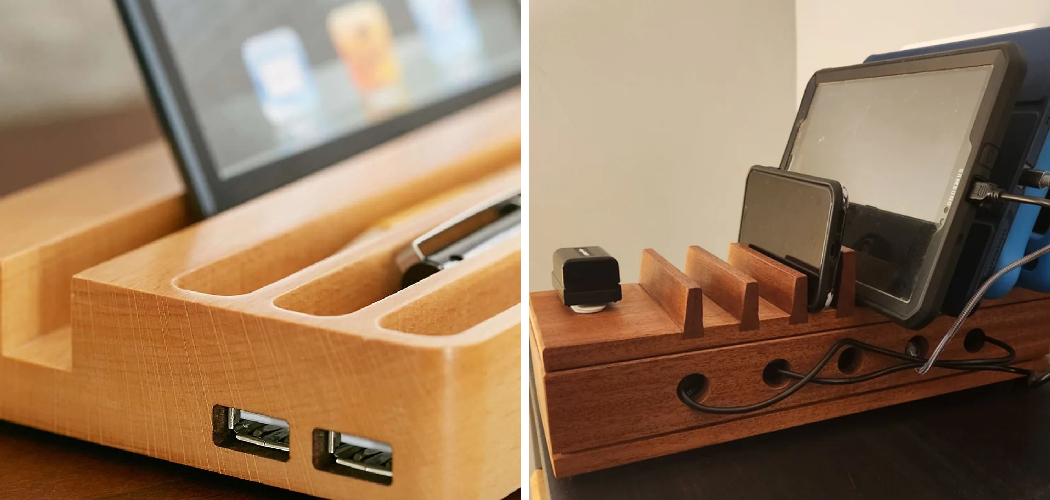Are you tired of finding your devices scattered all over the house and running out of battery in critical moments? A charging station may be the solution you need.
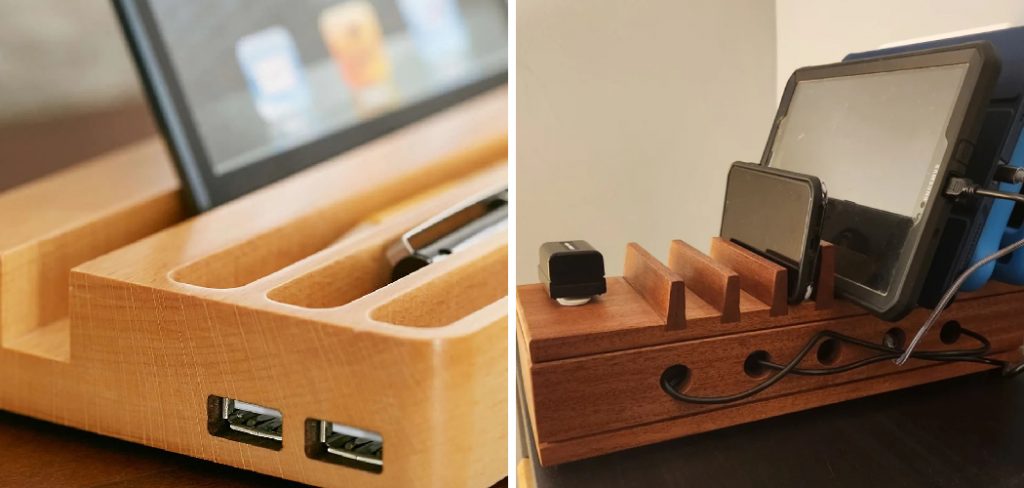
Creating a dedicated charging station in your home can bring organization and convenience to your daily routine, keeping all your devices powered up and within reach. Whether you are a tech enthusiast with many gadgets or someone looking to simplify your charging setup, building a charging station is a straightforward project that can be customized to fit your specific needs.
In this guide on how to build a charging station, we’ll cover the steps involved in designing and assembling a functional and aesthetically pleasing charging station that efficiently manages cables, accommodates various types of electronics, and fits seamlessly into your living space.
What are the Benefits of Having a Charging Station?
Having a charging station offers several advantages, including:
- Convenience: With all your devices in one spot, you can easily charge them simultaneously without searching for multiple outlets.
- Organization: A charging station can help declutter your space and keep cords neatly arranged, reducing the risk of tripping or tangling.
- Protection: Plugging and unplugging devices repeatedly can damage the charging port, but a dedicated station eliminates this risk.
- Customization: You can design your charging station to suit your needs and preferences. For example, you may include extra storage or incorporate wireless charging capabilities.
These are just a few of the benefits of having a charging station in your home. Now, let’s dive into the steps involved in building one.
What Will You Need?
Before getting started, gathering all the necessary tools and materials is essential. Your exact requirements may vary depending on your preferences and the type of charging station you want to build. However, here are some general items that will likely come in handy:
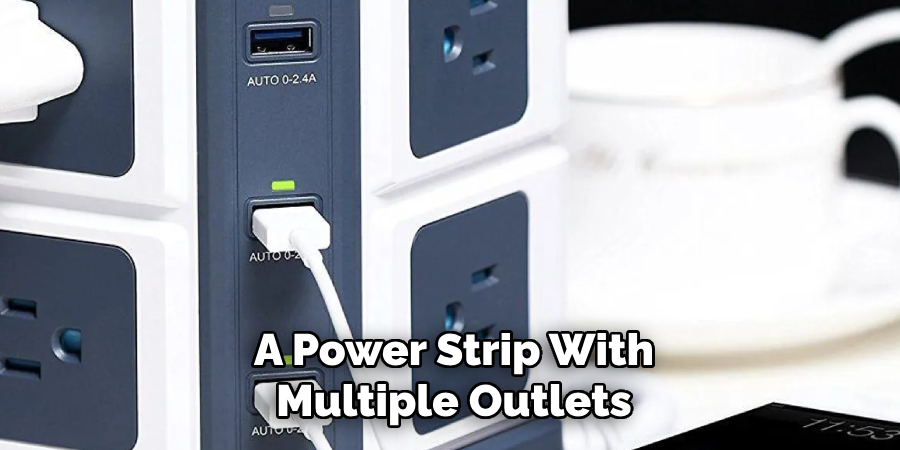
- Power Strip: A power strip with multiple outlets is essential for a charging station. Look for one with surge protection and enough space between each outlet to accommodate bulky chargers.
- Charging Cables: Ensure you have all the necessary charging cables for your devices. Consider getting longer ones if you want to keep your station organized and uncluttered.
- Cable Clips or Ties: These are useful for keeping cables tidy and preventing them from tangling.
- Wood/MDF Board: You will need a sturdy board to serve as the base of your charging station. Consider using MDF (Medium-Density Fiberboard) for a smoother finish.
- Drill and Screws: You’ll need these to attach the power strip and cable clips/ties to the board.
- Paint or Stain: If you want to give your charging station a more polished look, consider painting or staining the board before assembling.
- Decorative Elements: This is optional, but you can add decorative elements such as washi tape, stickers, or vinyl decals to personalize your charging station and make it stand out.
With these items ready, it’s time to start building your charging station. Let’s get into the steps.
10 Easy Steps on How to Build a Charging Station
Step 1. Designing Your Charging Station
Before you start drilling or painting, planning out your charging station’s design is critical. Consider factors such as the number of devices you’ll need to accommodate, the size of your power strip, and how much space you have available in the station’s area.
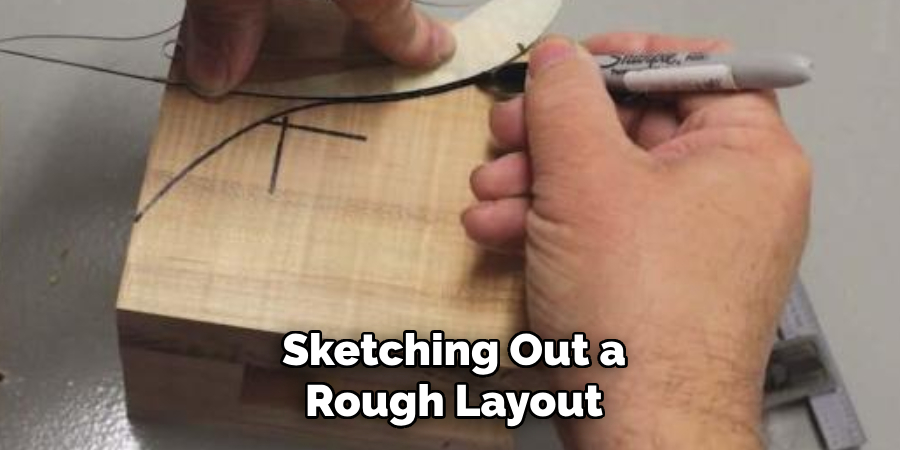
Consider whether you’ll want to include a space for tablets and laptops or smaller devices like phones and smartwatches. Sketching out a rough layout can help you visualize how everything will fit together and ensure you’re pleased with the final arrangement before moving forward to the construction phase.
Step 2. Selecting and Preparing the Board
The foundation of your charging station is the board that will hold all your devices and manage the cables. Select a board that’s the appropriate size based on the design you sketched in Step 1. MDF is a good choice due to its smooth surface, which makes it easier to drill and modify.
Cut your board to the necessary dimensions, and sand any rough edges for a clean, safe finish. After sanding, clean the board of any dust before painting or staining it to match your home décor. Allow the finish to dry completely before proceeding to the next step.
Step 3. Attaching the Power Strip
With your board prepared and the finish dried, it’s time to install the power strip. Position the power strip on the board where you want it to be located—typically toward the back to leave room for the devices in front. Once placed, mark the screw holes of the power strip onto the board.
Pre-drill the holes to make the final attachment easier and prevent splitting the board. After drilling, secure the power strip using screws, making sure it’s firmly attached and that there’s no wiggle room. If your power strip has a built-in surge protector, make sure it’s accessible in case it needs to be reset.
Step 4. Organizing and Attaching Cables
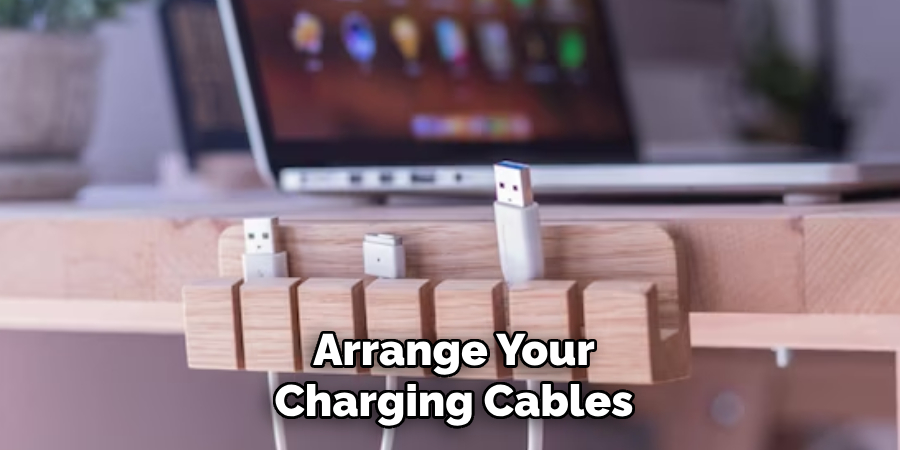
Once the power strip is in place, the next step is to arrange your charging cables. Lay out the cables according to where your devices will sit, ensuring each has enough length to reach comfortably without clutter. Use cable clips or ties to fasten the cables to the board, maintaining a neat and organized appearance. This will also prevent the cables from getting tangled or damaged when you attach or remove your devices.
If your charging station design includes a storage compartment for surplus cable lengths, ensure this space is easily accessible.
Step 5. Creating Device Slots
Depending on the number of devices you plan to charge, you can create slots or compartments on your charging station to keep everything organized. Measure and mark where you want your devices to go, ensuring there is adequate space for each item. If you’re using MDF or wood, you can cut grooves or use a router to create slots for your devices to stand upright.
Each slot should be slightly wider than your thickest device to allow for easy placement and removal. Sand the edges of the slots to prevent scratching your devices. If you prefer a more straightforward setup or plan to charge devices of varying sizes, consider using adjustable dividers that can be moved or removed as needed.
Step 6. Adding the Finishing Touches
After all functional components are secured, it’s time to add those finishing touches that will make your charging station unique. This is where you can get creative with decorative elements. If you’ve opted for paint or a stain, now would be the time to add patterns, stickers, or decals. Consider implementing some personal flair with stenciling or hand-painted designs.

If you desire even more functionality, add a small lamp or LED strip for better visibility at night. Inspect your charging station to ensure all screws are tight, the power strip is functioning correctly, and the cables are neatly organized. Your charging station is now an efficient organizational tool and a representation of your style.
Step 7. Testing Your Charging Station
Before finalizing the placement of your new charging station, it’s essential to test every aspect for functionality. Plug in all the devices you plan to charge and ensure each cable works properly and reaches without strain. Check the stability of the power strip’s attachment and the firmness of the device slots or compartments.
This is also an excellent time to test the surge protector, if applicable, to ensure devices are safeguarded against electrical spikes. Any last-minute adjustments should be made now before the charging station entirely becomes a part of your daily routine.
Step 8. Choosing the Ideal Location
Finding the perfect spot for your new charging station is pivotal for both accessibility and aesthetics. Ideally, it should be placed in a conveniently reachable area that doesn’t clutter your living space. Consider proximity to where your devices are most often used and to an electrical outlet for ease of wiring.

Placing it out of direct sunlight might also be worthwhile to protect your electronics from excessive heat. Ensure the surface underneath is stable and doesn’t wobble to prevent any potential drops or damage to your devices. After selecting the location, gently place your charging station and organize your devices accordingly.
Step 9. Maintenance and Care
Maintaining your charging station will ensure its longevity and functionality. Periodically, dust off the surface and inspect the cables for wear and tear. If you notice any frayed wires or loose connections, replace the cables immediately to prevent damage to your devices or potential electrical hazards.
Additionally, check that the power strip’s surge protector is functioning correctly, especially after any power outages. Keep the area around your charging station clear of liquids and food to avoid spills that could harm electronic components. With proper care, your charging station will remain a reliable hub for powering all your devices.
Step 10. Troubleshooting Common Issues
In the event you encounter issues with your charging station, a systematic approach to troubleshooting can save you time and frustration. Start by ensuring all cables are securely connected and the power strip is turned on. If a device isn’t charging, try using a different cable or plug it directly into a wall outlet to rule out a faulty cable or power strip socket.
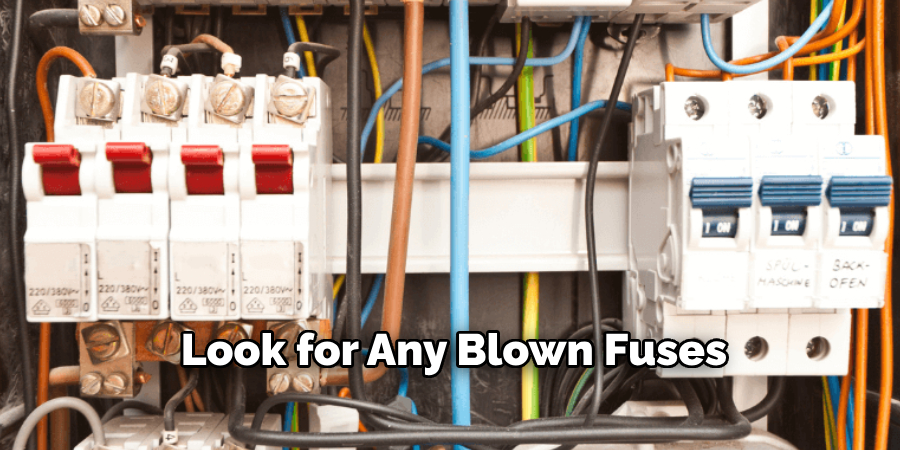
Look for any blown fuses or tripped surge protectors that may have cut power to the strip. Also, ensure that the charging slots or compartments are not exerting pressure on any cables or device ports. Keep manufacturer’s guides or warranties handy for reference if any persistent issues arise with specific devices or the power strip.
By following these steps, you can create a personalized and functional charging station that will make managing your devices more straightforward and more efficient. Remember that there is no “perfect” way to design a charging station, so feel free to experiment with different materials and configurations until you find what works best for you.
5 Additional Tips and Tricks
- Integrate Cable Management Solutions: To prevent cables from becoming tangled and to maintain a neat appearance, integrate built-in cable management systems into your charging station design. Consider using clips, hooks, or docks specifically made for cable organization.
- Opt for a Ventilated Design: Electronics can generate substantial heat when charging. Ensure your charging station has proper ventilation to prevent overheating, which could damage your devices.
- Use Smart Plugs for Energy Efficiency: Connect your charging station to smart plugs. These devices can be controlled via smartphone apps and have timers to cut power when charging is complete, saving on energy.
- Select an Accessible Location: Place your charging station in a convenient area of your home or office where it can be easily accessed without obstructing traffic flow. This helps ensure devices are charged when needed and keeps them within reach.
- Safety First: When building a charging station, always prioritize safety. Use surge protectors to safeguard your devices from voltage spikes. Be mindful of the power load to prevent overloading circuits. Choose materials that are non-conductive and fire-resistant for added protection.
With these additional tips and tricks, you can elevate your charging station to be both functional and efficient.
5 Things You Should Avoid

- Overcrowding: Avoid cramming too many devices into your charging station, leading to overheating and potential fire hazards.
- Incorrect Placement of Devices: Make sure to properly place devices in the charging station to avoid blocking ventilation or causing damage to ports and cables.
- Cheap Materials: Make sure to use quality materials for your charging station. Cheap materials can be flammable or lead to electrical hazards.
- Lack of Labeling: Properly label each cable and port in your charging station to avoid confusion and prevent damaging devices or ports by using the wrong cable.
- Forgetting to Unplug Unused Devices: Always remember to unplug devices once fully charged to save energy and prevent potential hazards. Leaving devices plugged in for extended periods of time can also decrease their battery lifespan.
By avoiding these common mistakes, you can ensure the safety and functionality of your charging station for years to come. Remember to regularly check and maintain your charging station to keep it in top condition.
What Type of Charger Should You Choose for Your Charging Station?
When it comes to selecting a charger for your charging station, there are a few options to consider. Some popular choices include USB chargers, wireless chargers, and multi-port chargers. Each has its own advantages and drawbacks.
- USB Chargers: These are the most common type of charger and typically come with multiple USB ports. They are compact, affordable, and widely compatible with various devices. However, they may have a slower charging speed.
- Wireless Chargers: These chargers use induction technology to charge devices without cables. They are convenient and eliminate the need for multiple cables, but they may have slower charging speeds and can be more expensive.
- Multi-port Chargers: These chargers have multiple ports and can charge multiple devices simultaneously. They come in various sizes and configurations, making them a versatile option for charging stations. However, they may be more expensive and take up more space.
Ultimately, the type of charger you choose will depend on your specific needs and preferences. Consider the number of devices you need to charge, the required speed, and the space you have available for your charging station. So, choose wisely to ensure an optimal charging experience.
Is DC Charger Faster Than AC?
The charging speed depends on various factors, such as the type of charger, the capacity of the battery being charged, and the amount of power being supplied. In general, DC chargers are considered faster than AC chargers because they provide a more direct flow of electricity to the charged device.
However, this may only sometimes be the case, as some modern AC chargers have advanced charging technologies that can provide similar or even faster charging speeds compared to DC chargers. Ultimately, the charging speed will depend on the specific charger and device being used.
So, it is always recommended to do some research and compare different options before making a decision. Remember also to consider safety factors when selecting a charger for your charging station.
Conclusion
In conclusion, building an efficient and safe charging station is an endeavor that requires careful planning and consideration of various factors. By incorporating effective cable management, ventilation, smart energy practices, strategic placement, and stringent safety measures, you can create a station that charges devices quickly, conserves energy, and extends the lifespan of your electronics.
Moreover, knowing what to avoid is just as critical as avoiding common pitfalls such as overcrowding, subpar materials, and inadequate labeling. When choosing chargers, weigh the pros and cons of USB, wireless, and multi-port options in relation to your specific needs. Whether opting for AC or DC chargers, always prioritize safety and compatibility. Your charging station will testify to functionality, safety, and technological harmony with these guidelines.
Hopefully, this guide has provided you with the necessary information on how to build a charging station. Keep these tips in mind and enjoy the convenience and efficiency of a well-designed charging station. Happy charging!

